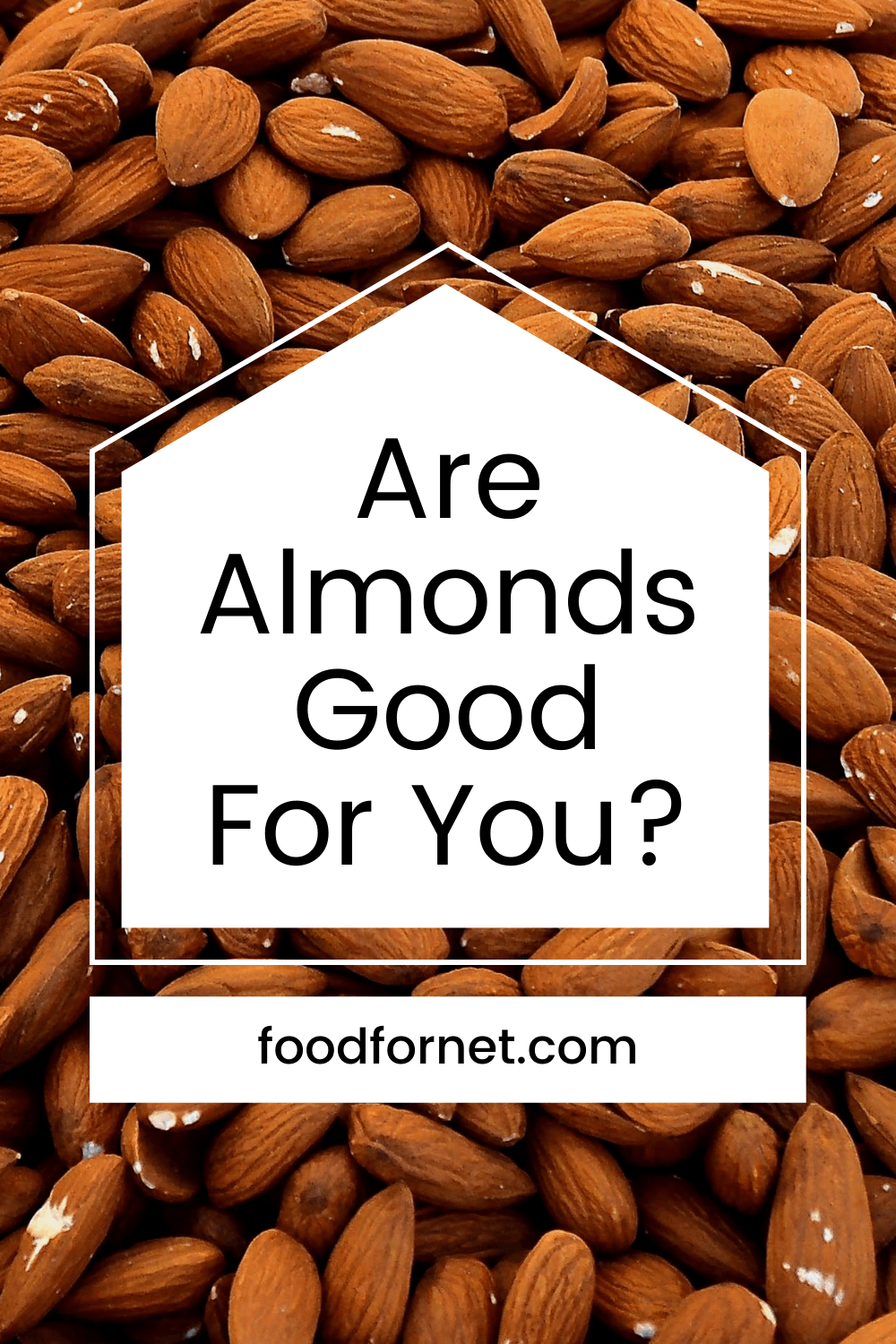
The growth in almond consumption has been astonishing. From 2005 to 2014, Americans ate 220% more almonds than ever before, while other tree nuts didn’t see the same spike in popularity at all. So, what is it that makes this little nut so special? Why are almonds good for you and are they as amazing as they first seem?
To answer these questions, we need to talk about the popularity of almonds.
We once called nuts unhealthy because they’re high in fat and fat is the enemy. Well, it was the enemy. These days, we know that fat itself isn’t inherently bad for us. Some types of fat can even promote heart health, including the fat we find in almonds.
Almonds have also been heavily promoted. Countless studies show that almonds are beneficial, as long as you don’t overdo it. However, there are also some issues, including the high calorie content of almonds and their omega 6 content.
We also need to ask, how do almonds compare to other nuts? They’re often seen as being much healthier, but some of that perception might just be the result of clever marketing.
Are Almonds Good For You?
- The Benefits Of Almonds
- Why Almonds Aren’t As Good As They Seem
- Are Almonds Bad For The Environment?
- Should You Soak Almonds?
- How Almonds Compare To Other Nuts
- What About Almond Milk?
- What About Almond Butter?
- Final Thoughts
The Benefits Of Almonds
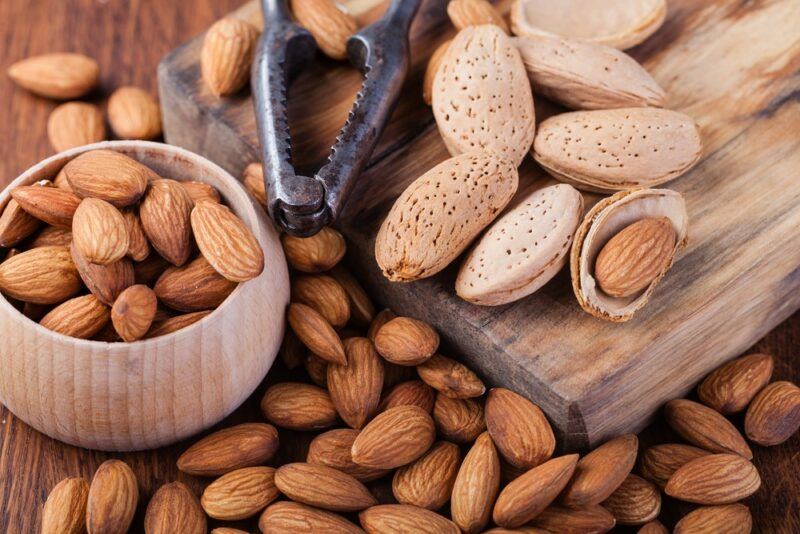
They’re Highly Nutritious
Almonds are most famous for their nutrients, so let’s start there. Almonds contain a decent amount of vitamin E, manganese, and various B vitamins, along with iron, potassium, and calcium. There are smaller amounts of many other vitamins and minerals too.
All of these nutrients are essential for your health.
For example, the B vitamins play a role in energy metabolism, helping your body to create energy (which is why you often see B vitamins in energy drinks). So, if you’re not currently getting enough B vitamins, almonds may help with your energy levels.
Similarly, calcium helps with your bones, along with your heart, other muscles, and nerves. Almonds are an easy way to increase your calcium intake, especially if you’re not eating dairy.
Vitamins and minerals aren’t the only powerful compounds that almonds offer. The nuts also contain antioxidants. As you’ve probably heard, antioxidants help to fight free radicals. In doing so, they may reduce oxidative damage and reduce the risk of disease in our bodies.
They’re A Source Of Healthy Fat
The fat content of almonds was once seen as a bad thing. These days we understand that fat isn’t necessarily the enemy. Some types of fats can even be good for you, including monounsaturated fats, which are very common in almonds.
The monounsaturated and polyunsaturated fats in almonds have even been linked to decreased heart disease risk. In particular, almonds can help to increase levels of HDL cholesterol (the ‘good’ kind), while decreasing LDL levels (the ‘bad’ kind).
The Protein And Fiber
Almonds also contain plenty of protein and fiber. These are both macronutrients that are critical for the function of our bodies.
Protein is made up of amino acids, which are used to help grow and maintain the cells and tissues throughout our body. If our protein intake is lacking, our bodies don’t work well at all.
Thankfully, most of us are already getting enough protein to avoid deficiency. Still, increased protein may help in some areas, like weight loss, muscle development, and illness recovery.
Almonds are particularly powerful here, as they give you 6 grams of protein in a 1-ounce serving. Pistachios are the only common tree nut with a similar amount of protein.
Almonds excel in their fiber content too, offering around 4 grams of fiber per serving.
These amounts might not sound like much compared to fiber rich foods like navy beans, but remember that peanuts are small and easy to eat. They provide an excellent amount of nutrition for their size.
Almonds Promote Health
The nutrients, macronutrients, and plant-based compounds in almonds are all relevant for your health, providing a broad range of benefits.
For example, almonds can help reduce various risk factors for heart disease, including decreasing cholesterol levels, blood lipids, and HDL cholesterol levels. The fiber in almonds has health benefits too, helping to improve digestion and keep your body working as it should.
Almonds can also be very relevant for anyone with type 2 diabetes or metabolic syndrome. Both groups of people benefit from the low carb nature of almonds, as this means that almonds don’t increase blood sugar levels much.
There’s still more research to be done and the health benefits of almonds won’t affect all people equally. Even so, with so many potential benefits, including almonds in your diet regularly just makes sense.
They Can Help With Weight Loss
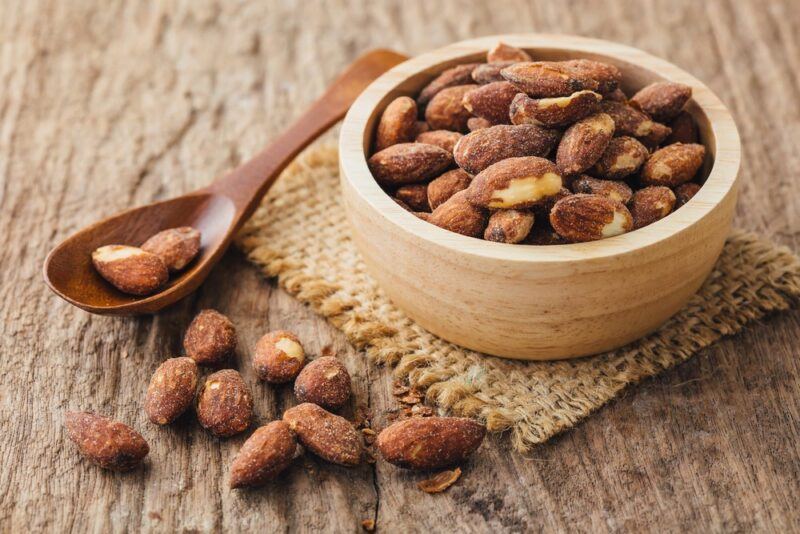
While almonds are relatively high in fat and calories, they can still help with weight loss. This is partly because of the protein. Protein rich foods tend to help you feel full, so you’re less likely to crave sugary or calorie rich snacks.
Having some almonds as a snack, for example, is an easy way to keep you going between meals. Plus, because almonds are relatively low in carbs, they don’t lead to a blood sugar spike then crash.
There’s even the chance that almonds increase your metabolism slightly and that your body doesn’t absorb all the calories that they contain. Some studies highlight this weight loss effect, while others have found that snacking on nuts doesn’t lead to weight gain.
This is all good news for losing weight, but you still need to be careful.
Most of the studies that link almonds to weight loss did so in specific circumstances. For example, some kept participants on calorie-controlled diets. So, the participants who ate almonds needed to decrease their calorie intake elsewhere.
This isn’t surprising, as almonds are calorie dense. To eat almonds and still lose weight, you’ll need to keep a close eye on your portions. You might also need to decrease your calorie intake elsewhere.
They’re A Fantastic Snack
Snack food doesn’t get much better than almonds. The nuts are convenient, easy to eat, and are packed with protein.
The combination of fat, fiber, and protein means that nuts will keep you full for a while. That’s not all. Because you’re more satisfied, you’re less likely to crave snacks and sugary food.
Almonds can even be a better snack than ‘healthy’ options like rice crisps and plain popcorn. Snacks like those might seem perfect because they’re low in calories, but eating them is a little like eating air and you get hungry soon after.
The Saturated Fat Content Is Low
Almonds might be full of fat, but there isn’t much saturated fat present. You get just 1 gram of saturated fat in an ounce of the nuts. This is less than most other tree nuts.
Many people try to keep their saturated fat intake low, as saturated fat has been linked to a variety of health problems, including increased heart disease risk. Almonds are an easy way to get healthy fats without consuming much saturated fat.
There is plenty of debate about whether saturated fat is as bad as it seems. Some research even suggests that the fat mightn’t increase heart disease risk like we once thought.
Yet, even if saturated fat isn’t the dietary villain that we often expect, it doesn’t appear to offer many health benefits either. We also don’t know the health effects of regular high saturated fat intake. This suggests that you should still have plenty of low saturated fat foods in your diet too.
Why Almonds Aren’t As Good As They Seem
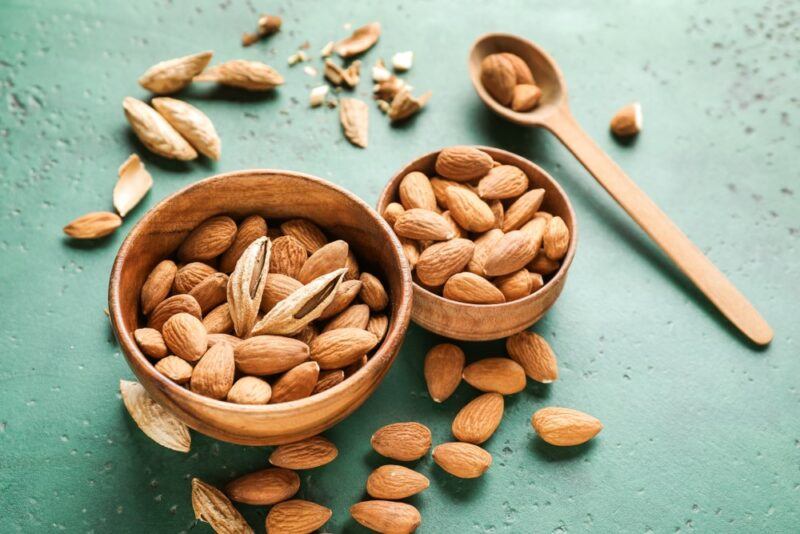
Their Carb Content
Almonds do have their issues too, starting with their carb content. This is relatively high, as you get roughly 9 net grams of carbs in a 3.5 ounce serving.
Whether this is an issue depends on how you’re using almonds and your serving size. After all, plenty of keto recipes use almond as an ingredient, including recipes for smoothies, bread, and fat bombs.
And, of course, there are plenty of debates about what carbs mean for your health anyway. Many of the problems with carbs are linked to simple and refined carbs, particularly those in processed foods. Nuts don’t fall into that category at all.
So, if you’re not concerned about the carbs in whole foods or you keep your portion sizes small, almonds can still work well.
They’re Calorie Dense
Almonds contain somewhere between 160 and 200 calories per ounce, depending on how they’re prepared. While this isn’t too bad for the range of nutrients in the nuts, the calorie content still adds up quickly.
Don’t forget that these are nuts we’re talking about. Many of us find them semi-addictive, especially when they’re cooked in oil and seasoned. It’s easy to eat many more almonds than we intended to.
This is where almonds can easily be a problem. People who struggle with self-control can easily end up gaining weight from nuts, which pretty much negates the benefits.
If you’re in that camp and find that you regularly overeat almonds, then it might be best to ignore them altogether. After all, you can get similar nutrients and antioxidants from plenty of other foods.
They’re Expensive
Almonds are much more expensive than peanuts and the high demand for the nuts is simply driving up the price. If you’re on a tight budget, you might not be able to afford almonds at all.
There’s also the question of whether they’re worth the price. They’re delicious and nutritious, true, but so too are less expensive nuts. You actually get many of the same benefits from peanuts, which are much easier on your wallet.
The Ratio Of Omega 3 To Omega 6
Almonds contain omega 3 and omega 6 fatty acids, which are polyunsaturated fatty acids. They’re both considered healthy, but they have different effects on your body.
Studies suggest that diets with a high ratio of omega 3 to omega 6 promote health by decreasing inflammation, heart disease risk, and other issues. Unfortunately, modern diets are often the reverse, where people are consuming too much omega 6 and not enough omega 3.
Almonds can make this issue worse, as they contain barely any omega 3 fatty acids and a decent amount of omega 6.
None Of Their Features Are Unique
Almonds provide plenty of nutrients in a small package, along with protein, fiber, and antioxidants. With all the marketing that surrounds almonds, it’s easy to be convinced that they’re the next big thing – that they’ll dramatically improve your health.
Let’s be honest though.
The health benefits of almonds mostly come from the nutrients and macronutrients. You can get these in plenty of other places. What about all the nutrient-dense foods that are low in calories, like leafy greens?
Don’t forget about legumes, whole grains, and alternatives like quinoa. These all give you plenty of nutrients. Many of them offer fiber and protein as well.
Besides, while protein, fiber, vitamins, and minerals can all promote your health, their effects are linked to whether you need them to begin with. Most nutrients don’t do much at all if you’re already getting enough of them.
Almonds Are High In Oxalates

Oxalates are naturally occurring compounds that can be problematic, especially in large doses. Part of the issue is that oxalates bind calcium. Because of this, they can increase your risk of kidney stones. They can also decrease your absorption of some minerals.
You can still consume some oxalates without a problem. However, if you’re at risk for kidney stones, you may need to cut down on oxalate rich foods and keep your intake under 100 mg or even 50 mg per day.
Nuts can be a problem here, as most of them contain some oxalates. Almonds are particularly concerning, with an ounce of almonds containing more than 100 mg of oxalates. So, if you’re at risk for kidney stones, you might need to cut almonds out entirely.
Are Almonds Bad For The Environment?
Some articles talk about the dark side of almonds and almond milk. The issue is mostly connected to how much water is needed to grow almonds. Seriously. A single almond needs roughly 1.1 gallons of water to produce. That’s a lot of water.
Plus, all of the almonds grown in the United States come from California. There’s now a multibillion California industry around almonds, making them incredibly lucrative for the state and farmers. While California is clearly a good environment for growing almonds, the state also faces severe water shortages. A crop like almonds doesn’t help matters at all.
Farming almonds amid a water shortage could easily cause flow-on effects, like collapsed roads because the aquifers have been drained too much.
That’s not the only problem either.
The almond industry is huge. It relies heavily on infrastructure, bees, and land. This type of mono-industry always comes with problems, especially when most of the growing is being done in a single state.
These issues all make almonds sound alarming. However, many other crops use the same amount of water as almonds, if not more. Let’s not forget about dairy either. That industry uses much more water than any type of tree nut.
And, as some authors point out, almonds are a high value crop. They might require a large amount of water, but they’re also very nutritionally dense and are important economically for the state.
Almond producers are taking responsibility too, with many focusing on micro irrigation systems or other ways to reduce water use.
How this balances out depends on your values and priorities. Almonds do use a lot of water, that’s true, but perhaps they’re not as horrible as we’re told.
Should You Soak Almonds?
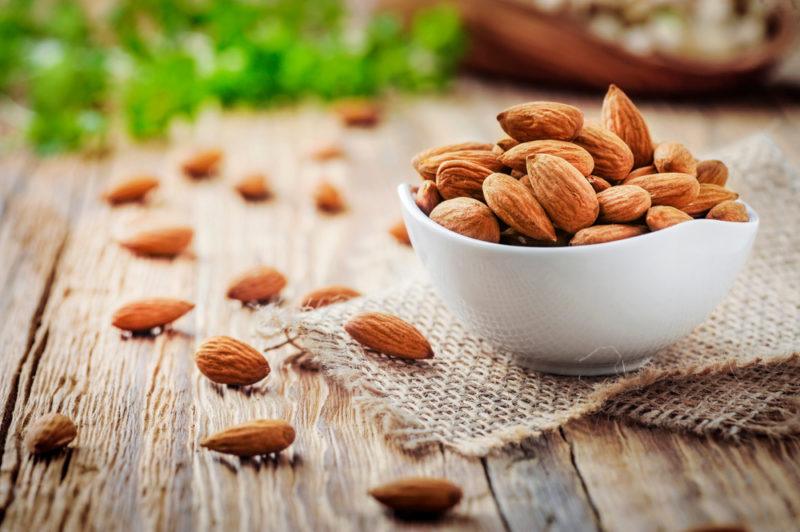
Some recommendations suggest that you should soak almonds before eating them.
Doing so makes the almonds softer and easier to digest. The improved digestion may also mean that we get more nutrients from soaked almonds than from unsoaked ones.
This effect is partly because soaking decreases the amount of phytic acid. Phytic acid is considered an antinutrient. It’s also present in grains and legumes, and is one of the reasons that people soak beans before eating them.
Plus, when you soak almonds, the skin is easier to remove. Getting rid of the skin might sound like a strange idea, as this is where the most powerful plant-based compounds are found. But, the skin does contain tannins. These are harder to digest than the rest of the almond and could even decrease your absorption of some nutrients.
Still, whether you soak them or not, almonds are good for you. You’re getting plenty of nutrients either way.
To soak or not to soak comes down to personal preference. You might choose to soak your almonds to get access to more nutrients and to improve digestion, or you might leave them as-is to give the nuts a better appearance and flavor, and to get the plant-based compounds from the skin.
How Almonds Compare To Other Nuts
Almonds are often seen as the single healthiest type of nut. They’re also far more popular than other types of tree nuts, by a wide margin, although this rapid increase in interest is relatively recent.
As we’ve already seen, almonds offer clear benefits and could easily improve your health. Still, most of the same benefits apply to other types of nuts, as they’re all a source of plant-based protein, nutrients, and healthy fats.
For a one-ounce serving, the main nuts break down like this:
- Almonds. 160 calories, 6 g protein, 14 g fat, 1 g saturated fat, 6 g carbs, 4 g dietary fiber. High in potassium, magnesium, vitamin E, and calcium.
- Cashews. 160 calories, 4 g protein, 13 g fat, 3 g saturated fat, 9 g carbs, 1 g fiber. High in zinc, folate, and iron, with moderate amounts of magnesium and potassium.
- Brazil nuts. 190 calories, 4 g protein, 19 g fat, 4.5 g saturated fat, 3 g carbs, 2 g dietary fiber. High in potassium, magnesium, zinc, and selenium.
- Walnuts. 190 calories, 4 g protein, 18 g fat, 1.5 g saturated fat, 4 g carbs, 2 g dietary fiber. Fewer nutrients than other types of tree nuts, but often linked to improved brain health.
- Pistachio nuts. 160 calories, 6 g protein, 13 g fat, 1.5 g saturated fat, 8 g carbs, 3 g dietary fiber. High in potassium and vitamin B6.
- Macadamia nuts. 200 calories, 2 g protein, 22 g fat, 3.5 g saturated fat, 4 g carbs, 2 g dietary fiber. Contains some nutrients, but the amounts are less impressive than other tree nuts.
Almonds end up being one of the best choices for protein, fiber, and calories – features that are all excellent for snacking. The nutrient densities are impressive too.
Still, if you take a close look at the nutritional differences, you’ll see that the variation isn’t that significant. I mean, let’s be honest, the difference between 6 grams of protein and 4 grams per serving won’t be noticeable most of the time.
There’s one more difference to mention – the marketing. Almonds are more heavily promoted than any other type of nut. Plenty of articles focus on the benefits of almonds, not to mention all of the sales pitches.
There’s even an Almond Board of California. One of their main goals is “developing global market demand for almonds”, so it’s not surprising that they’re so heavy-handed in saying that almonds are amazing.
What About Almond Milk?
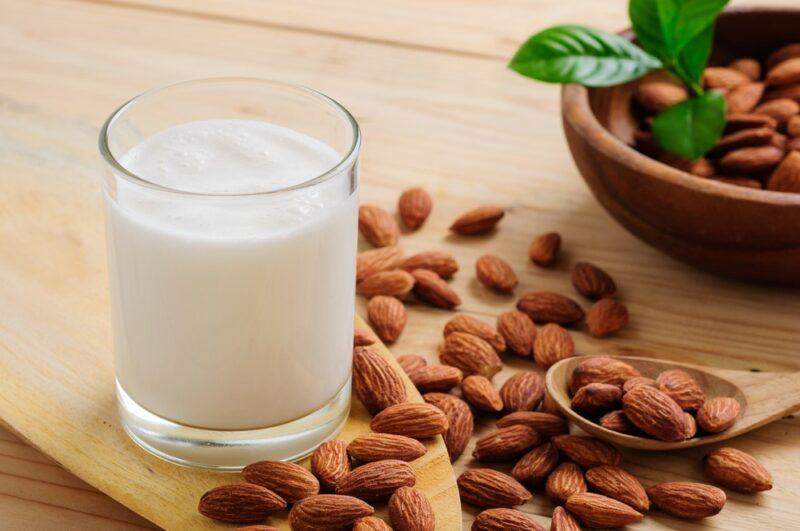
Almond milk is made from almonds, but it won’t give you the same benefits that you get from the nuts. This is because almond milk is mostly water. Commercial varieties often contain around 2% almonds. The rest is water, sugar, and additives.
You can increase the almond content by making almond milk at home. This gives you a healthier drink, one that skips the concerning additives. Even so, you’re still mostly drinking water.
The nutrition of almond milk isn’t a bad thing, not really. It means that almond milk will keep you hydrated. Plus, most people use almond milk as a replacement for dairy milk. It doesn’t need to be nutritious to perform that role. You can get your nutrients elsewhere.
What About Almond Butter?
High quality almond butter is made from almonds and little else. So, unlike almond milk, it can be an easy way to get all the nutrients that almonds have to offer.
From that perspective, almond butter is a healthy choice.
The problem is that almond butter is still calorie dense. You get around 200 calories and close to 19 grams of fat with just 2 tablespoons of almond butter. And, let’s be honest, 2 tablespoons isn’t that much. It’s easy to use more than this in a sandwich or on toast without meaning to.
Because of this calorie density, it’s worth measuring out your almond butter, rather than trying to judge it by eye. This way you know how much you’re eating and can avoid having too much.
Final Thoughts
There’s no denying the benefits of almonds. Plenty of studies prove that almonds can promote health in a variety of ways, partly because almonds are such a nutrient dense food.
The biggest issue is the calorie content. It’s easy to overdo it with almonds, especially if you love snacking anyway. Still, most of us can keep our portions in check with a little planning and care.
That being said, almonds aren’t the amazing superfood they’re made out to be. You can get similar benefits from other foods, many of which aren’t as calorie dense.
So, should you eat almonds? If you love them and can keep your portions under control, then by all means. But, if you’re not a huge fan, then don’t worry, ignoring almonds isn’t going to hurt you.
Frequently Asked Questions
Are Almonds Keto Friendly?
Almonds contain 9 net grams of carbs per 100 gram serving, which makes them feasible for keto, but not ideal. In contrast, macadamia nuts contain just 5 net grams of carbs for the same serving size, while walnuts contain 7.
There is also a huge number of keto almond recipes, including those for fat bombs, smoothies, and even almond bread. Some of these use almond milk or almond flour, but others rely on almonds themselves.
Are Almonds Good For Diabetics?
Nuts, including almonds, are fantastic for diabetes. Their low GI means that they won’t spike your blood sugar levels. Having a few after a meal might even help keep your blood sugar stable.
The main issue is the calorie content, as a handful of almonds contains more than 150 calories. Consuming too many can lead to weight gain, which then raises the risk of diabetic complications.
Do Almonds Go Bad?
Almonds can indeed go bad. This happens because the oils they contain oxidize and the nuts become rancid. This oxidation happens more quickly when the nuts are exposed to light, heat, and oxygen.
Keeping almonds in a sealed container in the fridge decreases these issues and the nuts stay fresh for longer. If you do this, then natural almonds should stay good for two years, while roasted almonds will last roughly a year.
Are Almonds Gluten Free?
Almonds themselves are gluten free. However, dry roasted almonds sometimes use wheat as part of the coating. To get around this, look for plain nuts or those that have just been salted.
You can also roast almonds yourself. This way you can easily avoid any gluten containing ingredients.
Can You Eat Raw Almonds?
Raw almonds are a little like raw milk – they’re edible but potentially dangerous, as they can easily be infected with bacteria. This is why most raw almonds aren’t actually raw. They’ve been pasteurized instead. That process kills microbes and makes the almonds safe to eat.

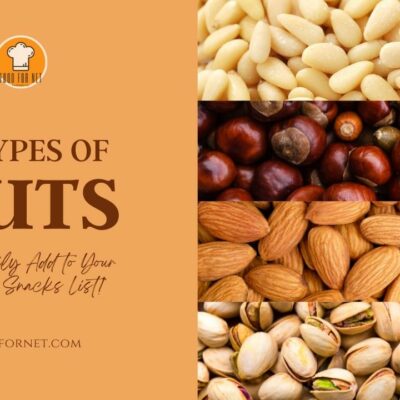

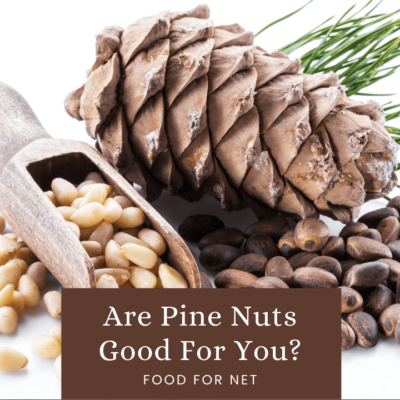

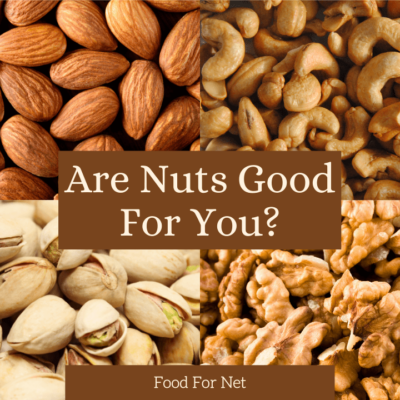

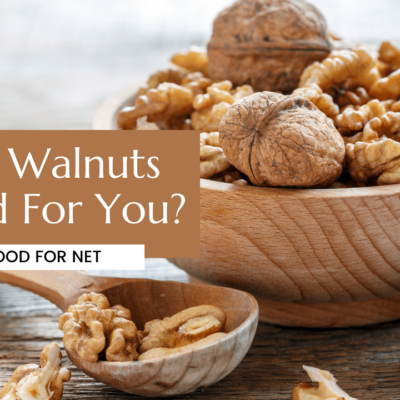

 6 Nightshade Vegetables to Eat (or Not to Eat)
6 Nightshade Vegetables to Eat (or Not to Eat)
Leave a Reply